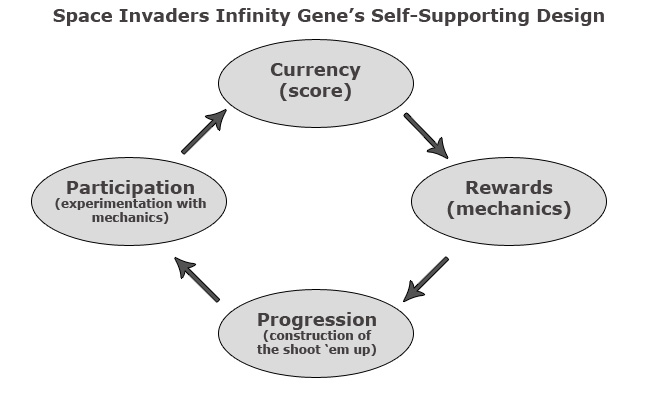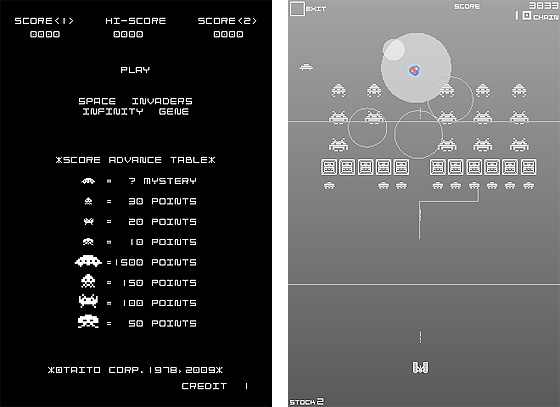Space Invaders: Infinity Gene – Construction of the Shoot ’em Up
August 28th, 2010
Since popularising the shoot ’em up in 1978, the Space Invaders series practically went dormant for thirty years. Sure, Taito rolled out sequels and anniversary editions, but rarely did these games evolve the series in any meaningfully sufficient way. Such thinly-veiled cash-ins on the Space Invaders namesake could barely meet the legacy they were supposedly representing. The series’ presence in modern gaming was an embarrassment, to be sure. In recent years though, with the release of Space Invaders Extreme and its sequel, Taito have done good on one of gaming’s longest surviving brands by doing what they failed to get right before: tampering with the source.
In this light, Space Invaders Infinity Gene isn’t so much an expansion of an already great game like Extreme, but instead a tribute; an interactive construction of Space Invaders‘ legacy: the modern shoot ’em up. And it all begins from stage one, the original Space Invaders, before moving into progressively more contemporary territory.
Like most age-old shoot ’em ups, in Infinity Gene, the player increases their score through a combo system. However, after completing a stage or losing a life, you’re not presented with a high score table, but instead the points earned act as a currency which fill out an evolution meter. Once you’ve maxed out the meter the game “EVOLVES”. Evolving adds one of three things to Infinity Gene: new mechanics, bonus stages or graphic and sound unlocks.
Replaying a level, which you are free to do at any time, will give you another shot at adding more blue juice to the bar. As you progress it becomes harder to score the points necessary to evolve, meaning that repeated plays slowly become a requirement of pushing the mechanical game forward. Yet ideally—and particularly in the later stages—you don’t want to be spending your time replaying the same level repeatedly just to gain an extra inch of blue fill. You do, however, still want to max out the evolution bar since the pay-off for doing so will make life easier by adding new gameplay mechanics. The result is well-crafted baiting, but calling Infinity Gene a game of baiting would be to do the game a great disservice. Points are gained on the grounds of skilfully employing combos and hitting targets (although you can grind if you need to) and the rewards are new tools which feed back into the loop of gaining points. The more points you earn, the more “arms” (shooting techniques) are made available via a selection screen preceding each level, giving the player more applicable options in meeting the challenges of the changing level design. So, experimentations and commitment leads to rewards which foster more experimentation and commitment. By commodifying the traditional points system, Infinity Gene’s gameplay becomes more relevant to regular players (as opposed to high scoreboard chasers) in that it facilitates a system of progression tied to the context of the game (evolution). Of course, high scoreboards are still present for those who wish to pursue them.
Once players make it through the initial comfort stages, Infinity Gene switches up its enemy patterns to suit the different “arms”, persuading the player to first explore with their new tools. Later, experimentation become mandatory as the design moves into a tertiary phase where only certain arms are applicable in defeating the enemy patterns present in each stage. This sort of involving level design which motivates the player to be creative with the tools they are provided with leads back into the currency of points. The more the player understands the various arms, the better off they are for gaining high combos and claiming a better score which they are in-turn rewarded with more tools.
Speaking in the ethos of the game itself, Infinity Gene is a construction, where the player constructs a modern day shmp, piece by piece, through their committal to the scoring system (the very foundation of the arcades, also part of the ethos). In Infinity Gene the means support the ends as can be seen in this diagram:
Now let’s add some squiggly lines:
It’s worth explaining the squiggly lines in the diagram. They are the underlying methods of persuasion used ensure the player remains active within this framework. Firstly, to the far right, persuasion of completism is the human tendency for no stone to be left unturned. This is the reason why Tetris is so addictive, our cerebral matter craves order in a world of clutter. Tetris creates clutter, the player creates order and the two forces create an addictive dynamism. Infinity Gene feeds our obsessive compulsive nature via the user interface of the level select screen. The main levels are mapped out along the spine of an evolution tree with 2 branches possible at either side. Since the player can only evolve once per stage, the interface keenly marks all the evolutions which have yet been reached, enticing the player to correct the apparent mistake.
Secondly, the centre point, the player is made to believe that the game is evolving (even if they themselves are not personally evolving the game very much) through the minor visual details added to each progressive level. Level-to-level, nuance forms around the crusts of the visual design, until a set of stages are completed and the presentation reboots with new colours and effects.
Lastly, as the player progresses, the layout of the levels (which transition from blank emptiness to more structural as you go along) and enemy placements begin to favour a wider variety of “arms”, nudging, and at times forcing, the player to actively use the tools in which they’re unlocking.
A Conclusion on Conclusions
Concluding the analysis here, I can’t help but comment on the most effective part of Infinity Gene: the ending. After building up Space Invaders through the lens of Gradius, R-Type and the bullet hell sub-genre, among others, the game ends, the credits roll and then suspiciously, after the dust settles, a variant of the original Space Invaders loads up with a lone invader rapidly making its descent to the bottom of the screen. Immediately, the tactile feeling reverts back to 1978, you’re power-ups and arms are removed and the game changes completely, leaving you with a sudden point of comparison. This game about evolution devolves to the base value in order for its magnitude to be understood. Personally speaking, the impact felt at this point validates all of the play up to that stage.
Conclusion
Space Invaders: Infinity Gene isn’t trying to make up for 30 years of cruddy ports, but rather it’s a documentation of the shoot ’em up genre during the period of time the self-proclaimed “KING OF GAMES” went intro retirement. Infinity Gene is a successful title, because it takes us on a journey where we meaningfully construct the results of a legacy left abandoned. The guts it takes to do this is commendable, but the execution is even more so.







 Game Design Companion: A Critical Analysis of Wario Land 4 - $7.99
Game Design Companion: A Critical Analysis of Wario Land 4 - $7.99 Level Design: Processes and Experiences
Level Design: Processes and Experiences Speed Boost: The Hidden Secrets Behind Arcade Racing Design - $5.99
Speed Boost: The Hidden Secrets Behind Arcade Racing Design - $5.99 Adventures in Games Analysis: Volume I - $5.99
Adventures in Games Analysis: Volume I - $5.99







